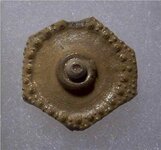Hi!
I'm a total amateur in the field of fossils and I'm pretty sure this isn't exactly the correct forum, but I thought I'd give it a shot anyway.
If found the following fossil in Brighton, UK last year. Can anyone tell me what it is?

Thanks!
Christian Liljeberg
I'm a total amateur in the field of fossils and I'm pretty sure this isn't exactly the correct forum, but I thought I'd give it a shot anyway.
If found the following fossil in Brighton, UK last year. Can anyone tell me what it is?

Thanks!
Christian Liljeberg









